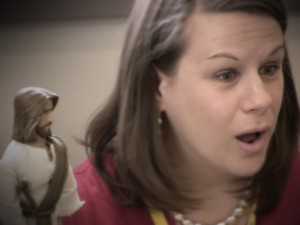Written Learning Goals and Objectives
Another way to help parents and teachers in their effort to educate their children would be to have written learning goals and objectives. Doug Fields has written a book entitled Purpose Driven Youth Ministry. What makes this book different from any other “how to do youth ministry†book is that he introduces the concept of identifying “H.A.B.I.T.S. â€[1] that students should be encouraged to implement into their lives.[2] These are activities that students do outside of structured church programs and are an effort to get students to have a quiet time, an accountability partner, memorize Scripture, etc., on their own, away from adult supervision. Field’s theory is that if these “H.A.B.I.T.S.†truly become second nature in the lives of the students, they will more than likely carry them over when they graduate out of youth ministry. The strength of this concept is that he has identified a short list of six things that the youth ministry can focus on and encourage in the lives of the student.
With regard to a strategy of equipping children within the local church, it would be helpful to provide parents and teachers with a list of learning objectives that the church feels are fundamental to the child having a balanced and maturing relationship with God.[3] These learning goals can even be broken down by appropriate age range. For example, two-year-olds would have completely different objectives than second graders. In order for the material to be reviewed over time these various sets of learning objectives could build upon one another over the course of the child’s time in the church’s children’s ministry.
Someone may ask, “But what if a new student comes into the class or a student misses several lessons?†This lack of knowledge on a particular topic (missions, evangelism, Samson, for example) can be dealt with by making the topics cyclical in nature. For example, a first and second grade class may learn about “missions†and when they graduate up to the third and fourth grade class, they may study it again. Instead of repeating the old material, it will be reviewed and new material will become the focus. At each class level, even though the same topics may be covered, the learning objectives change toward becoming more complex.[4]
There are several benefits of having written learning goals and objectives. One is that the teachers have a clear list of learning objectives that can help them in evaluating if their teaching has been effective. Second, parents have a clear list of learning objectives so that they can be working on these concepts at home, in the car to the soccer game, during bath time, or whenever the parent thinks would be an appropriate time to teach.[5] The third benefit is that the home and the church can work together, in concert to see that the child’s life conforms to the set biblical teaching objectives and life habits. It has been said that, “what is not evaluated is not worth much.†It is humanity’s natural tendency to drift toward mediocrity rather than push toward improvement and growth. Therefore, a fourth benefit of learning objectives is that it encourages the teacher to do a good job of teaching because he knows that his ministry will be evaluated when the child “graduates†to the next class. There will also be a form of outside evaluation when the child goes home and the parents ask them questions based on the set learning objectives. In discussing this concept of written goals and learning objectives Barna says,
One of the most startling revelations I encountered on this journey was finding that many of the effective ministries have a long-term plan—in some cases an 18-year developmental plan with specific ideals outlined for each age groups from infants through high school seniors. While those churches allow for spontaneity and flexibility despite their long-range planning, they are fully committed to implementing their “big picture†plan.[6]
A teacher may have teaching objectives for a given year, and she may even have learning objectives that she has developed on her own, but for her ministry to be successful these goals have to coincide with the “big picture†for the child’s spiritual development.
A fifth benefit of having written goals and objectives is that the teaching ministry of a church from nursery to high school can function as a team, with one level building upon the next until the child is mature in Christ.[7] A teacher or parent could reference the learning goals and objectives and seek to help one another in their teaching efforts. It is in essence a map for everyone to follow, so that one could get to the desired destination; a growing disciple of Christ.
[1] HABITS is an acronym where the “H†stands for Hang Time With God, “A†stands for Accountability Partner, “B†stands for Bible Memorization, “I†stands for Involvement in the Church, “T†stands for Tithing, and “S†stands for Studying the Bible.
[2] Fields, Purpose Driven Youth Ministry, Chap. 9.
[3] See Appendix A
[4] See Appendix B for an example of how topics can be repeated with the learning objectives becoming more complex.
[5] Deut 6:7–9
[6] Barna, Transforming Children Into Spiritual Champions, 100.
[7] “Maturing†as defined in Heb 5:14, “But solid food is for the mature, who by constant use have trained themselves to distinguish good from evil.â€Â (NIV)
